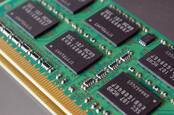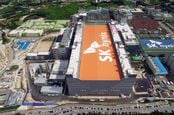This article is more than 1 year old
To get a sense of Samsung's Q2 profits, picture a Galaxy Fold closing to half the size
NAND if you think it's bad now, wait 'till Japan's trade sanctions bite
Samsung's quarterly profits have been cut in half by shrinking smartphone sales and the ongoing memory oversupply crisis.
Everyone's favourite chaebol reported (PDF) revenues of ₩56.13 trillion ($48bn) for the second quarter of 2019, the three months to 20 June, down 4 per cent year-on-year, but its net profit was reduced to ₩5.18 trillion ($4.4bn), down 56 per cent, as factors outside the company's control annihilated its gross margins.
Just like its compatriot SK Hynix did last week, Samsung warned that its financials could be further impacted by trade tensions between South Korea and Japan, which are disrupting the flow of key silicon-etching ingredients.

But of course the US and China's trade war is making those godDRAM oversupply issues worse
READ MOREThe trade war between the US and China continues, and there are still too many DRAM chips on the shelves, so the company admitted it will have trouble forecasting its free cash flow through to 2020.
"We faced various challenges from uncertain conditions not only in our business areas, but also from growing global macro environment," Robert Yi, senior veep for investor relations at Samsung, said during an earnings call.
"Despite these current challenges, we will continue our efforts to secure a mid to long-term growth by strengthening competitiveness of our new business via delivering innovative component technologies and continuing our leadership as a 5G solution provider.
"In addition, investments in future technologies such as systems semiconductors, artificial intelligence and automotive solutions will remain a key focus."
Samsung's semiconductor business reported quarterly revenue of ₩16.09 trillion ($14bn), and its operating profit was down 71 per cent to ₩3.4 trillion ($2.9bn). The company said it was affected by "inventory adjustments" by major data centre customers but added that demand for DRAM and NAND chips actually started picking up already – and it expected sales to recover further in the second half of the year. Yi also noted that the company observed a marked decline in demand for chips used for cryptocurrency applications.
The display panel business reported ₩7.62 trillion ($6.4bn) in revenue and ₩750bn ($635m) in operating profit for the quarter.
The consumer electronics division reported ₩11.07 trillion ($9.4bn) in quarterly revenue and ₩710 billion ($600m) in operating profit, with the company highlighting improved profitability of refrigerators and washing machines.
Meanwhile, Samsung's mobile business shipped 83 million smartphones and about 5 million tablets between April and June. The division actually increased its revenue to ₩25.86 trillion ($22bn), despite Samsung shipping 8 per cent fewer phones during the first three months of the year than it did in Q1 2018. And yet operating profit declined 42 per cent year-on-year to ₩1.56 trillion ($1.3bn).
"Mobile profitability declined due to slower flagship sales, major spec enhancements of the new mid and low segment devices, and an increase in marketing expenses," Yi said. In the network business, earnings remained solid due to fast uptake of 5G in Korea.
According to IDC, global smartphone shipments sank 6.6 per cent in the first quarter of the year when compared to Q1 2018 – the sixth consecutive quarter of decline.
Samsung's overall quarterly operating profit stood at ₩6.6 trillion ($5.6bn) – "a significant year-on-year decrease, mainly based on challenges in the memory and mobile businesses," Yi said.
In the second quarter, capital expenditure totalled ₩6.2tr ($5.24bn), including ₩5.2 trillion spent on semiconductors and ₩500bn on displays. The company noted that a larger percentage of this year's investment will be made in the second half, and that it plans to mass produce sixth-generation V-NAND later this year.
In terms of specific devices, Samsung pegged its smartphone recovery hopes on the upcoming launches of the Note 10 phablet and the Galaxy Fold, the first commercially available foldable smartphone – a device so expensive ($1,980) and unnecessary it just might become a best-seller. Right?
The launch of the Fold was originally scheduled for May, but had to be pushed back to September after review units started dropping like flies.
"We will focus on ensuring the successful third-quarter launches of the Galaxy Note 10 and Galaxy Fold as well as on improving profitability through improved operational efficiencies," Yi said.
"The network business will continue to build a strong foundation for expansion in the global 5G market based on its leadership in 5G commercialization in the US and Korea."
Samsung's board of directors approved a second-quarter dividend of ₩354 ($0.3) per share to be paid in August. ®

